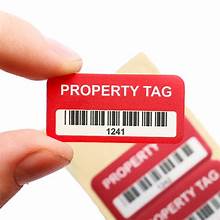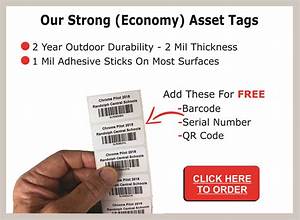Contact Numbers
Consumables / Labels


Asset tags are labels or identification markers used to keep track of and manage physical assets within an organization. They typically consist of a label or tag with information such as a unique serial number, barcode, QR code, or other identifiers that help in asset tracking and inventory management.
These tags are affixed to various types of assets, including equipment, machinery, computers, furniture, vehicles, or any valuable item that a company or institution wants to monitor and manage. Asset tags serve several purposes:
Asset Identification: Each tag carries a unique identifier, making it easier to identify and differentiate between assets.
Inventory Control: By scanning or manually recording the information on the asset tags, organizations can maintain accurate inventory records, track asset movement, and conduct audits efficiently.
Asset Tracking: Tags facilitate tracking an asset’s location, maintenance history, usage, and other relevant data throughout its lifecycle.
Asset tags can vary in design, material, and technology used (such as RFID tags for wireless tracking) based on the specific needs of the organization and the type of assets being managed. They play a significant role in asset management systems, helping organizations optimize resource allocation, prevent loss or theft, and streamline operations.
Asset labels are identification labels used to track and manage physical assets within an organization. They typically contain information such as asset numbers, barcodes, QR codes, or serial numbers to uniquely identify and catalog assets.
Asset labels play a crucial role in asset management by providing a systematic way to track, locate, and manage assets throughout their lifecycle. They help organizations maintain accurate records, prevent loss or theft, streamline inventory management, and facilitate maintenance and servicing schedules.
Asset labels may include essential information such as asset numbers, descriptions, locations, acquisition dates, serial numbers, barcodes, QR codes, and other relevant details depending on the organization’s asset tracking needs.
Asset labels come in various types, including barcode labels, QR code labels, RFID tags, metal asset tags, tamper-proof labels, and custom-designed labels. The choice of label type depends on factors such as asset type, environment, durability requirements, and tracking technology preferences.
Asset labels are typically applied directly to assets using adhesive backing or attachment methods such as screws, rivets, or cable ties. The label placement should be in a visible and easily accessible location on the asset to facilitate scanning and identification.
Yes, many asset labels are designed to withstand harsh environments including extreme temperatures, moisture, chemicals, UV exposure, and abrasion. Specialty materials such as polyester, vinyl, and metal are commonly used to ensure durability and longevity in challenging conditions.
Asset labels streamline inventory management processes by providing a quick and efficient way to scan and track assets using barcode scanners, mobile devices, or RFID readers. They enable organizations to conduct accurate asset audits, monitor asset movement, and reconcile inventory records.
Yes, asset labels can be customized with organization-specific information, logos, colors, and branding elements to align with corporate identity and asset management protocols. Customization options may also include barcode symbologies, numbering sequences, and asset classification codes.
While asset labels are designed to adhere securely to assets, they can be removed or transferred if necessary. However, removal may leave adhesive residue or damage the asset’s surface, so it’s essential to use proper removal techniques and consider the label’s intended lifespan.
Asset labels are available for purchase from label manufacturers, office supply stores, industrial suppliers, and online retailers specializing in asset management solutions. They are offered in various sizes, materials, adhesives, and customization options to suit different asset tracking needs.